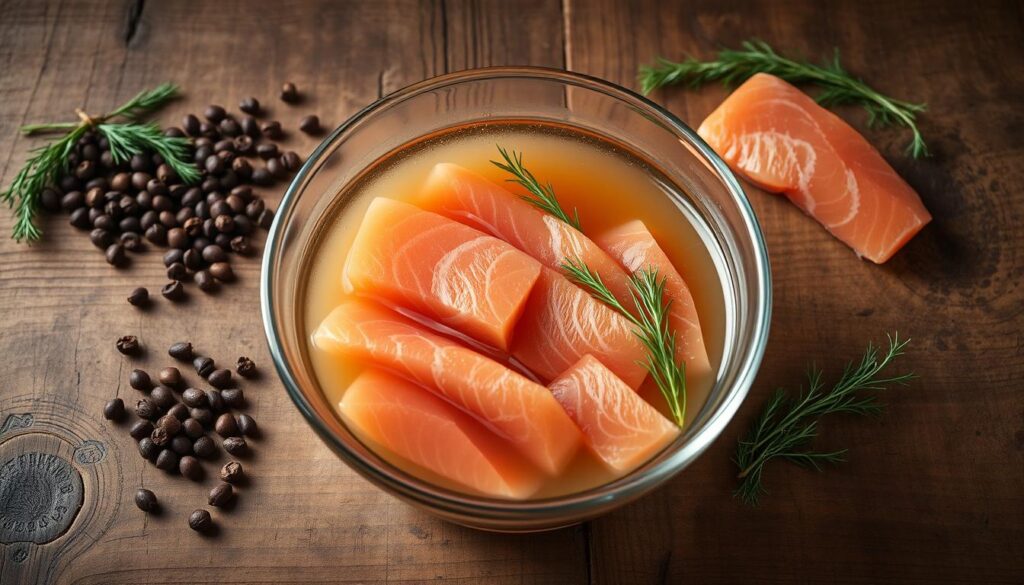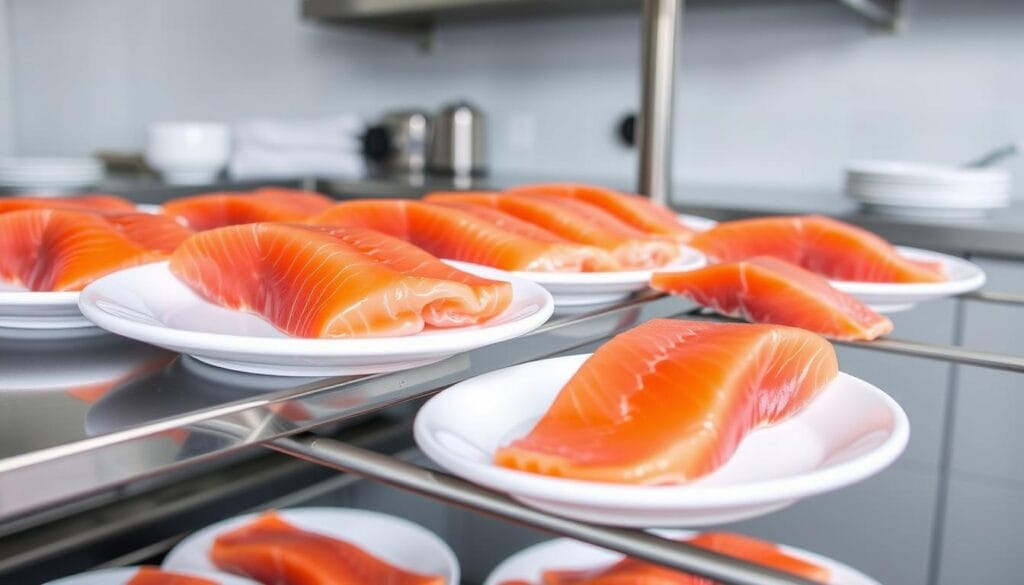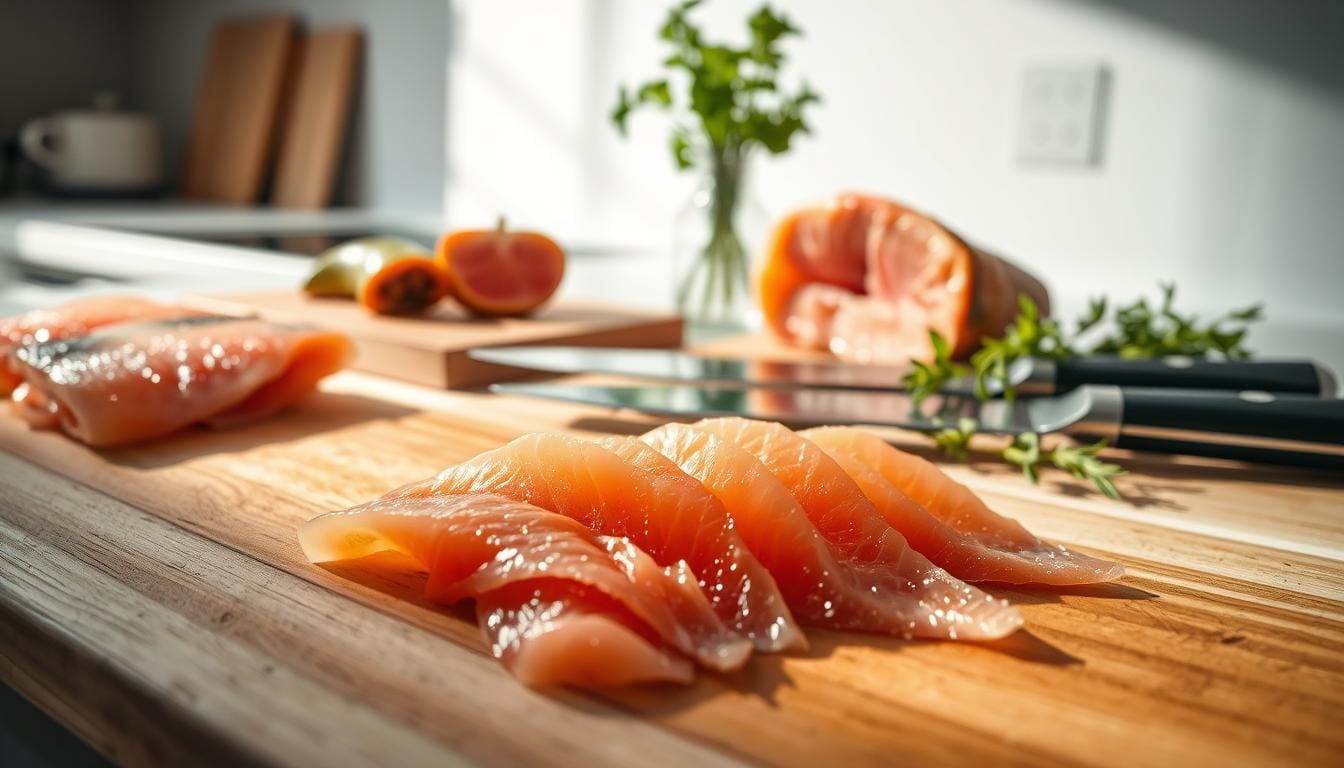Is Smoked Salmon Raw or Cooked? Everything You Need to Know
Table of Contents
The first time I tasted cold smoked salmon, I was amazed. Its silky texture and rich flavor left me wanting more. Many of us wonder: Is smoked salmon raw or cooked?
Whether smoked salmon is raw depends on the smoking method. Cold smoked salmon is preserved in a special way. It’s not cooked like usual food, but it’s safe and delicious.
Exploring smoked salmon reveals interesting facts about its making, safety, and taste. This guide is for everyone, from beginners to experienced chefs. It shows how to turn fresh salmon into a gourmet treat.
Let’s dive into the secrets of smoked salmon. We’ll look at how different smoking methods change its texture, taste, and health benefits. You’ll become an expert on this tasty seafood!
Understanding Smoked Salmon: A Historical Perspective
Smoked salmon has a long history that goes back thousands of years. Ancient people used special ways to keep food fresh. This changed how they stored and cooked food.
Smoking fish started in prehistoric times. People found that salt and smoke could keep food fresh longer. Coastal communities around the world learned to preserve their catch this way.
Traditional Smoking Methods
Early smoking methods were simple but worked well. Fishermen would:
- Salt fish thoroughly to remove moisture
- Hang fish over low-burning wood fires
- Dry fish in open-air environments
- Use local woods like alder or oak for unique flavor profiles
Evolution of Smoking Techniques
As time went on, making smoked salmon got better. European and Native American cultures developed their own smoking methods. These methods improved how food was kept fresh and tasted better.
Cultural Significance
Smoked salmon became more than just food. It became a special dish in many cultures. Countries like Norway and Scotland are famous for their smoking traditions. Native Alaskan communities also valued smoked salmon a lot.
“Smoking fish is not just cooking—it’s preserving history and tradition.” – Traditional Fisherman’s Saying
Is Smoked Salmon Raw? The Truth About Processing
Wondering if smoked salmon is raw? The answer isn’t simple. It depends on how it’s processed. There are two main ways to smoke salmon: cold smoking and hot smoking.
Cold-smoked salmon is almost raw. It’s smoked at low temperatures, between 70-90°F. This doesn’t cook the fish fully. So, it’s important to buy from trusted sources. If you’re worried about smoked salmon being raw, cold-smoked types need extra care.
- Cold smoking temperature range: 70-90°F
- Fish remains almost raw
- Higher risk of bacterial presence
Hot-smoked salmon, on the other hand, is fully cooked. It’s smoked at higher temperatures, 120-180°F. This kills harmful bacteria and makes the salmon flaky and cooked. This method makes the salmon safe to eat, removing worries about raw fish.
Knowing how smoked salmon is made helps you choose wisely. Always check the packaging or ask your supplier about the smoking method.
Pro tip: Pregnant women, young children, and those with weak immune systems should talk to doctors before eating smoked salmon.
Hot Smoking vs Cold Smoking Methods
Learning how to make smoked salmon starts with knowing the difference between hot and cold smoking. These methods change salmon’s texture, flavor, and how it’s prepared.
Smoking salmon is a special process that produces different flavors. Cold smoked salmon and hot-smoked salmon have unique tastes that people enjoy.
Temperature Differences
The main difference between these methods is the temperature:
- Cold Smoking: Temperatures range between 80-85°F
- Hot Smoking: Temperatures typically reach 120-180°F
Texture and Flavor Variations
Cold smoked salmon is silky and looks raw. Hot smoking makes it flaky and more cooked, with deeper flavors.
| Smoking Method | Texture | Flavor Intensity | Cooking Status |
|---|---|---|---|
| Cold Smoking | Silky, smooth | Subtle, delicate | Technically raw |
| Hot Smoking | Flaky, firm | Rich, intense | Fully cooked |
Processing Time Comparison
How long it takes to smoke salmon is different for each method:
- Cold Smoking: Needs 12-24 hours of smoke
- Hot Smoking: Takes 2-4 hours
Knowing these smoking techniques helps you choose the best way to make cold smoked salmon.
The Science Behind Smoking Salmon
Learning how to make smoked salmon means understanding the science behind it. Smoking salmon is not just cooking. It’s a way to preserve fish at a molecular level.
The smoking process uses science to protect and improve salmon. Salt is key in curing the fish, stopping bacteria from growing. During smoking, amazing chemical changes happen:
- Protein denaturation changes the salmon’s molecular structure
- Smoke compounds create a protective barrier
- Slight dehydration reduces the moisture content
Smoking salmon involves heat and smoke working together. Smoke contains phenolic compounds that fight off bacteria. These compounds make a protective layer on the fish, extending its shelf life and adding flavor.
Temperature control is vital when smoking salmon. Different temperatures affect the fish’s protein and moisture. Low temperatures, around 90°F, help create a pellicle. This tacky surface lets smoke stick better.
The art of smoking salmon is a delicate balance of science and culinary technique.
Reducing moisture in the fish is another key scientific step. Removing 20-25% of the water makes it harder for bacteria to grow. This process keeps the salmon fresh and intensifies its flavors.
Choosing the Best Salmon for Smoking
When you’re learning to make smoked salmon, picking the right fish is key. The type of salmon you choose greatly affects the taste and texture of your smoked salmon.
Start by understanding the difference between wild-caught and farm-raised salmon. Wild salmon often tastes stronger and is more nutritious.
Wild vs Farm-Raised Salmon
- Wild-Caught Salmon
- Higher omega-3 fatty acid content
- More intense natural flavor
- Better sustainability rating
- Farm-Raised Salmon
- More consistent availability
- Lower price point
- Milder flavor profile
Popular Salmon Species for Smoking
When you’re learning to make smoked salmon, consider these top salmon varieties:
- King (Chinook) Salmon
- Sockeye Salmon
- Coho Salmon
Quality Indicators
To pick the best salmon for smoking, look for these signs:
- Bright, vibrant color
- Firm flesh without soft spots
- Fresh, clean ocean smell
- High fat content (essential for smoking)
Pro tip for making smoked salmon: Choose salmon with at least 15% fat content for the best flavor. This ensures your smoked salmon is rich and moist.
Essential Brining and Curing Process

Learning to make smoked salmon begins with the brining and curing process. This step turns regular fish into a tasty treat with great flavor and texture.
Brining is more than just adding salt. It’s a key method that gets your salmon ready for smoking. It boosts both taste and keeps the fish fresh. Knowing how to brine is essential for making smoked salmon that tastes like a pro’s.
- Choose kosher or sea salt for the best brining solution
- Create a balanced brine with salt, sugar, and optional spices
- Submerge the salmon completely in the liquid
- Refrigerate during the entire brining process
The brining time varies based on the salmon’s thickness. Thin fillets need 2-4 hours, while thicker ones might take 8-12 hours. You want the fish to be firm and well-seasoned for smoking.
Important ingredients for a good brine include:
- Kosher salt
- Brown sugar
- Fresh herbs
- Peppercorns
- Garlic cloves
After brining, dry your salmon and let it get tacky. This step is vital for a shiny, glossy finish. It also helps the smoke stick to the fish.
Creating the Perfect Pellicle
Learning how to make smoked salmon means mastering the pellicle. This sticky layer helps the smoke stick to the fish. It’s key to a great final product.
The pellicle keeps smoke on the fish and stops moisture loss. It’s a thin, sticky layer that gives smoked salmon its smoky taste.
Drying Time Requirements
To get a perfect pellicle, follow these drying steps:
- Air-dry the salmon in cool air
- Let it dry for 5-24 hours
- Keep air moving around the fish
Surface Preparation Techniques
Getting the surface right is important for a great pellicle. Here’s how:
- Pat the salmon dry with paper towels
- Put it on a rack in a cool, airy place
- Wait for a slight sheen on the surface
“The pellicle is the secret weapon of professional smokers, creating that perfect smoky exterior.” – Culinary Smoking Expert
Your salmon is ready when its surface is slightly tacky and shiny. This means the pellicle is right, trapping smoky flavors during cooking.
| Pellicle Characteristic | Ideal Condition |
|---|---|
| Drying Time | 5-24 hours |
| Surface Texture | Slightly tacky and shiny |
| Temperature | Cool and consistent |
| Airflow | Good circulation |
Mastering the pellicle technique is your gateway to professional-quality smoked salmon that will impress even the most discerning food enthusiasts.
Temperature Control and Smoking Techniques
Learning to control temperature is key when smoking salmon without a smoker. The best temperature is between 225 to 275°F. This ensures your salmon cooks evenly and keeps its delicate texture and flavor.
You don’t need special equipment to make great smoked salmon at home. There are many ways to get professional-quality results:
- Grill smoking with indirect heat
- Oven smoking techniques
- Stovetop smoker methods
- Aluminum foil packet smoking
When smoking salmon without a traditional smoker, keeping the temperature steady is important. Use a meat thermometer to check the internal temperature and avoid overcooking.
| Smoking Method | Temperature Range | Approximate Cooking Time |
|---|---|---|
| Grill Smoking | 225-250°F | 2-3 hours |
| Oven Smoking | 250-275°F | 1.5-2 hours |
| Stovetop Smoker | 225-275°F | 1-2 hours |
Different smoking techniques can change your salmon’s taste and texture. Try using wood chips like alder, hickory, or applewood to find your favorite flavor when smoking salmon at home.
Storage and Shelf Life Guidelines
Keeping your cold smoked salmon fresh is key. Knowing how to store it right ensures you enjoy it safely and without worry.

Cold smoked salmon is very delicate. The way you store it greatly affects its taste and texture.
Refrigeration Best Practices
Here’s how to store cold smoked salmon correctly:
- Keep it in its original vacuum-sealed packaging
- Store it in the coldest part of your fridge
- Make sure the fridge stays below 40°F (4°C)
- Check the packaging for storage tips from the maker
Freezing Your Cold Smoked Salmon
Freezing can keep your salmon fresh for longer:
- Wrap it tightly in plastic or foil
- Put it in a freezer-safe bag or container
- Try to get rid of as much air as you can to avoid freezer burn
- Mark it with the freezing date
- It will stay good for up to three months
Recognizing Spoilage
Watch out for these signs that your salmon has spoiled:
- A slimy or sticky feel
- A bad or sour smell
- Changes in color or dark spots
- Mold
If your salmon looks or smells off, it’s best to throw it away. This keeps you safe from food poisoning.
Nutritional Benefits and Health Considerations
Smoked salmon is packed with nutrients that can improve your health. It’s great whether it’s raw or fully processed. This makes it a favorite among those who care about their health.
Smoked salmon is full of high-quality protein. This helps keep your muscles strong and your body working well. It also has lots of omega-3 fatty acids. These are good for your heart and brain.
- Protein: Approximately 18 grams per 3-ounce serving
- Omega-3 fatty acids: Support heart and brain function
- Vitamin D: Supports bone health and ithe mmune system
- Selenium: Powerful antioxidant properties
But smoked salmon needs careful thought. The smoking process can add more sodium. This might be a problem for people with high blood pressure. Cold-smoked salmon carries additional health risks. This includes pregnant women, the elderly, and those with weak immune systems.
“Moderation is key when enjoying smoked salmon’s nutritional benefits” – Nutrition Experts
Choose high-quality smoked salmon and watch your portion sizes. Wild-caught salmon is usually better than farm-raised.
Knowing if smoked salmon is raw helps you make better food choices. Even though it’s not completely raw, the smoking keeps many nutrients. This makes it a tasty and healthy choice when eaten in the right amounts.
Serving Suggestions and Culinary Applications
Cold smoked salmon is a game-changer in the kitchen. It turns simple dishes into gourmet delights. Let your creativity run wild with this tasty ingredient in many recipes.
Classic ways to enjoy cold smoked salmon include:
- Bagel topping with cream cheese and capers
- Elegant appetizer on crackers or crostini
- Salad ingredients adding rich protein
- Charcuterie board centerpiece
Chefs and home cooks love cold smoked salmon for its amazing taste. It can make any meal better, from breakfast to dinner.
Try these creative uses:
- Pasta dishes with cream-based sauces
- Savory quiches and frittatas
- Gourmet pizza toppings
- Sushi and sashimi preparations
Pro tip: Always slice cold smoked salmon thinly for optimal taste and texture.
For the best pairing, try crisp white wines, sparkling drinks, and light salads. These pairings will elevate your dining experience.
Conclusion
Understanding if smoked salmon is raw or cooked can change how you enjoy food. Smoking salmon uses special techniques to keep it tasty and safe. Whether you want to make it at home or just enjoy it, knowing the smoking methods is key.
Is smoked salmon raw? It depends on the smoking method. Cold-smoked salmon is not cooked, while hot-smoked salmon is cooked. Each method gives different tastes and textures, pleasing different tastes.
Your adventure with smoked salmon is just starting. Learning how to prepare, store, and choose it can make you appreciate it more. Think about the sodium and how it’s made when you add it to your meals.
Exploring smoked salmon opens up new food experiences. From old Pacific Northwest ways to new cooking ideas, it’s loved by many. Try making smoked salmon and find out the amazing flavors you can enjoy.
FAQ
Is smoked salmon raw or cooked?
What’s the difference between cold-smoked and hot-smoked salmon?
Is cold-smoked salmon safe to eat?
How long can I store smoked salmon?
What type of salmon is best for smoking?
Can I make smoked salmon at home?
What are the nutritional benefits of smoked salmon?
How do I know if my smoked salmon has gone bad?
What’s the best way to serve smoked salmon?
Is smoked salmon considered raw in sushi?
Did You Try Our Recipe?
There are no reviews yet. Be the first one to write one.

